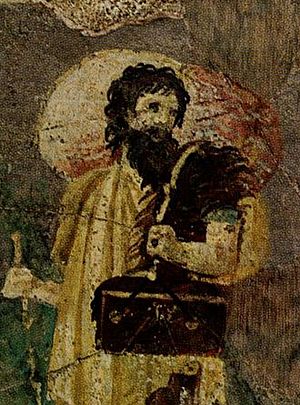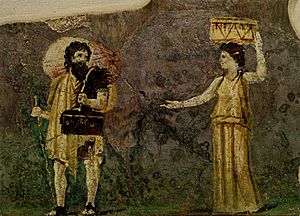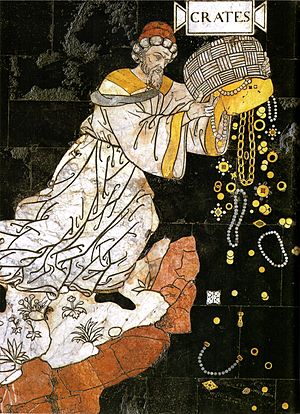Crates of Thebes facts for kids
Quick facts for kids
Crates of Thebes
|
|
|---|---|

Crates of Thebes. Detail from a Roman wall painting in the Villa Farnesina in Rome.
|
|
| Born | c. 365 BC |
| Died | c. 285 BC (aged 80) |
| Spouse(s) | Hipparchia of Maroneia |
| Era | Hellenistic philosophy |
| Region | Western philosophy |
| School | Cynicism |
|
Main interests
|
Cynicism, Asceticism |
|
Influences
|
|
|
Influenced
|
|
Crates (Greek: Κράτης ὁ Θηβαῖος; c. 365 – c. 285 BC) of Thebes was a Greek Cynic philosopher, the principal pupil of Diogenes of Sinope and the husband of Hipparchia of Maroneia who lived in the same manner as him. Crates gave away his money to live a life of poverty on the streets of Athens. Respected by the people of Athens, he is remembered for being the teacher of Zeno of Citium, the founder of Stoicism. Various fragments of Crates' teachings survive, including his description of the ideal Cynic state.
Life
Crates was born c. 365 BC in Thebes. He was the son of Ascondus, and was the heir to a large fortune, which he is said to have renounced to live a life of Cynic poverty in Athens. Diogenes Laërtius preserves several different accounts of this story; one of them has Crates giving his money away to the citizens of Thebes, apparently after seeing the beggar king Telephus in a tragedy; whereas another account has him placing his money in the hands of a banker, with the agreement that he should deliver it to his sons, unless they too became philosophers, in which case he should distribute it among the poor.
He moved to Athens where tradition says he became a pupil of Diogenes of Sinope; the precise relationship between Crates and Diogenes is uncertain, but there is one apparent reference to Crates referring to himself as "a fellow-citizen of Diogenes, who defied all the plots of envy". Crates is also described as being the student of Bryson the Achaean, and of Stilpo. He is said to have been deformed with a lame leg and hunched shoulders. He was nicknamed the Door-Opener (Greek: θυρεπανοίκτης) because he would enter any house and people would receive him gladly and with honour:

He attracted the attentions of Hipparchia of Maroneia, the sister of one of Crates' students, Metrocles. Hipparchia is said to have fallen in love with Crates and with his life and teachings, and thus rejecting her wealthy upbringing in a manner similar to Crates, she married him. The marriage was remarkable (for ancient Athens) for being based on mutual respect and equality between the couple. ..... They had at least two children, a girl, and a boy named Pasicles. .....
He was the teacher of Zeno of Citium in the last years of the century, and was undoubtedly the biggest influence on Zeno in his development of Stoic philosophy. Zeno always regarded Crates with the greatest respect, and some of the accounts we have of Crates have probably come down to us via Zeno's writings. His other pupils included Metrocles, Monimus, Menippus, Cleomenes, Theombrotus, and Crates' brother Pasicles. He may also have taught Cleanthes, Zeno's successor as head of the Stoic school.
Crates was, apparently, in Thebes in 307 BC, when Demetrius Phalereus was exiled there. He is said to have died at a great age (c. 285 BC), and was buried in Boeotia.
Philosophy
According to Diogenes Laërtius, Crates wrote a book of letters on philosophical subjects, the style of which Diogenes compares to that of Plato;. There are 36 surviving Cynic epistles attributed to Crates, but these are later, 1st-century, compositions.
Crates was also the author of some philosophical tragedies, and some smaller poems apparently called Games (Ancient Greek: Παίγνια, romanized: Paignia).
Several fragments of his thought survive.
Some of his philosophical writings were infused with humour, in the form of spoudaiogeloion. He urged people not to prefer anything but lentils in their meals, because luxury and extravagance were the chief causes of seditions and insurrections in a city. This jest would later be the cause of much satire, as in book 4 of Athenaeus' Deipnosophistae where a group of Cynics sit down for a meal and are served course after course of lentil soup.
One of his poems parodied a famous hymn to the Muses written by Solon.

There are also several fragments surviving of a poem Crates wrote describing the ideal Cynic state which begins by parodying Homer's description of Crete. The word tuphos (Greek: τῦφος) in the first line, is one of the first known Cynic uses of a word which literally means mist or smoke. It was used by the Cynics to describe the mental confusion which most people are wrapped-up in. The Cynics sought to clear away this fog and to see the world as it really is.
See also
 In Spanish: Crates de Tebas para niños
In Spanish: Crates de Tebas para niños


